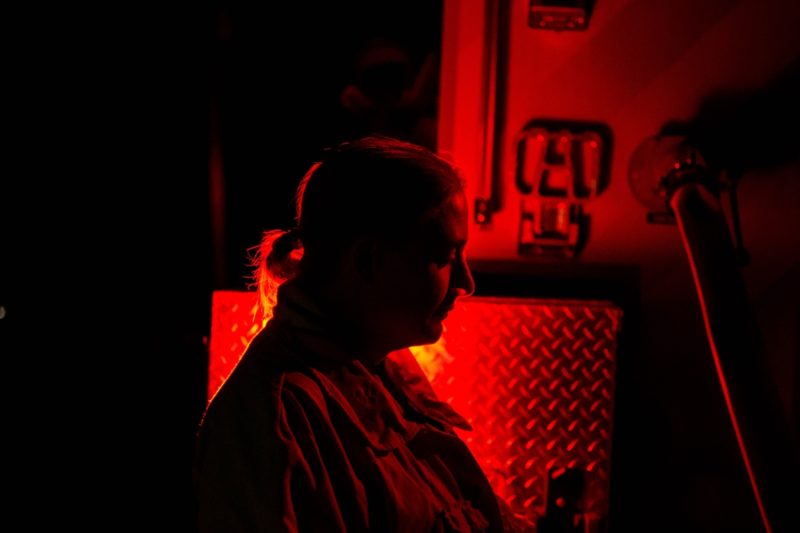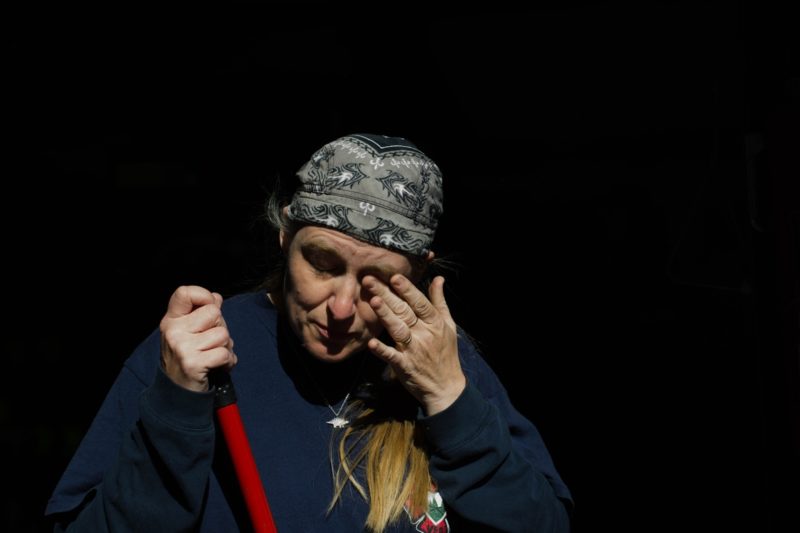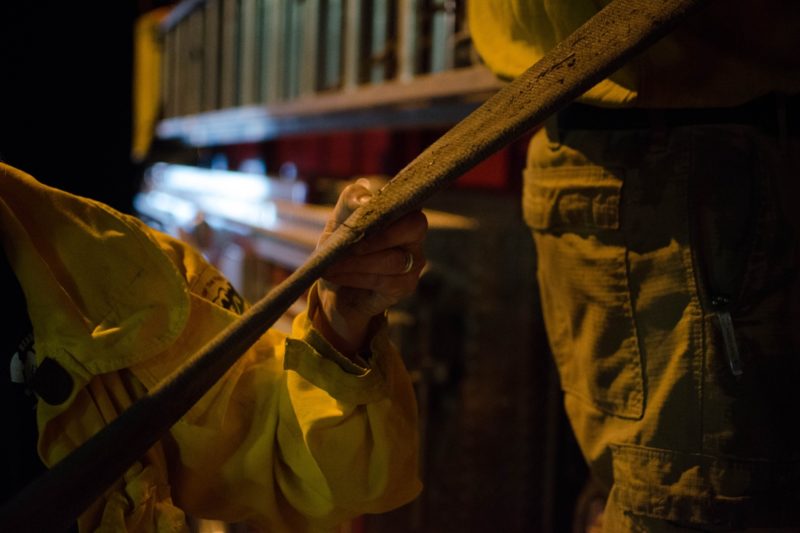From Chemistry Lab to Firefighting, UT Lecturer Wears Many Hats
By Yi Li
Photography By John Flynn
Reporting Texas

Sara Sutcliffe, a lecturer in the chemistry department at the University of Texas, also is a volunteer firefighter for Heart of the Pines Fire Department. She has been firefighting alongside her husband since 2008. John Flynn/ Reporting Texas
When Sara Sutcliffe was a young girl in West Sussex, England, she walked past a fire station near her grandparents’ home. As she did, a gate lifted and one of the massive trucks barreled out with its siren blaring. She ran down the street “screaming my head off.”
She avoided being anywhere near the fire station for years.
Three decades later, Sutcliffe’s world revolves around the Heart of the Pines Volunteer Fire Department in Bastrop. She rushes into burning houses when not teaching chemistry at the University of Texas at Austin and cannot imagine life without firefighting.
It all started with a simple request from her husband Scott, now the chief of the Heart of the Pines department and then a volunteer firefighter. “Can you bring me some tools to the station?” he asked Sara one day about 10 years ago. Gradually, she became “unofficial support” for the department, which has anywhere from 20 to 25 volunteers at a given time, and began to “just feel really cool” about firefighting.
“I could be doing it instead of just sitting at home worrying about whether [Scott] is OK,” she recalled thinking.
In 2008, three years into her job as a chemistry lecturer at UT-Austin, Sara Sutcliffe became a volunteer firefighter. In 2012 she took on a third job, teaching fire science in the Municipal Fire School at Texas A&M University.
Volunteer fire departments are essential to public safety in Texas, a state with more than 1,500 such departments. About 78 percent of fire services are provided by volunteers, according to the State Firefighters’ and Fire Marshals’ Association of Texas.
When Sutcliffe joined the Heart of the Pines department, she was its fourth female firefighter. Two of the original women have retired, but the department now has five female volunteers — including an assistant chief, which is rare in a male-dominated field. Only 3 percent of all firefighters in Texas are female, including full-time, part-time, and volunteer, according to the Texas Commission on Fire Protection.
Sutcliffe downplays the role of gender but is reminded of it from time to time, such as when nature calls and she struggles with a firefighting jumpsuit designed for a man.
“If you are a female, that ain’t going to be easy to use,” she said with a laugh, her long earrings shaking.

Though women make up 3 percent of firefighters in Texas, there are five female volunteers in her department, out of a total of fewer than 25. John Flynn/ Reporting Texas
At a fire scene, the Sutcliffes avoid thinking about out the fact that they are husband and wife.
“I fight fire with another firefighter who happens to be my wife,” Scott said.
But keeping their home life separate became impossible during a terrifying week in 2011, when the couple experienced up close the Bastrop Complex wildfire that destroyed about 1,600 homes. Sara and Scott lived in one of them.
When word came that their house was on fire, the Sutcliffes were saving a neighbor’s home. “We didn’t want him to lose his; he lost his in 2009,” Sara said.
Enormous clouds of thick black smoke filled the sky, covering a large part of Bastrop.
“The most horrible thing is driving down there knowing that I was going to see my house on fire, knowing that there was no damn thing I could do about it,” she said.
The strong winds rapidly accelerated the flames and the yaupons near their house burned like flash balls. They tried to fight the blaze, which to this day is the third most destructive in U.S. history, but failed. They had a chance to grab only a few things from their house.
Now, on the door of Sutcliffe’s office at UT, there is a picture of her standing near four pine trees. She planted them in the first spring after the disaster, when she and Scott moved into their rebuilt home on the same land. She takes a similar picture every year on the anniversary of the fire.
Stability is more important than ever for her. Even moving offices at UT isn’t easy.
“It’s going to be very sad for me leaving this office, because this is the one thing in my life that basically looks exactly the same that hasn’t changed since 2011,” she said softly, looking around the room.
On her desk, she keeps two stacks of business cards — one for her teaching job, one for her firefighting job. She has tried to keep them from interfering with each other, even during the Bastrop Complex Fire. The day after her house was destroyed, she showed up to teach.
“I’m wearing brush gear,” Sutcliffe recalled with a smile on her face and tears in her eyes. “I just said something random like, ‘Sorry if I seem a little bit out of it today, but my house burned down yesterday,’ and then I just started teaching.”

Sutcliffe assists in putting away the firehoses. They must be placed in a way that allows for rapid deployment in an emergency. John Flynn/ Reporting Texas
Unlike firefighting, her interests in chemistry were rooted in childhood. When she was a kid, she enjoyed mixing random things and watching an educational TV program with her father every Sunday morning. She describes herself as “a long-time geek.” After college in the U.K., she moved to Austin in 1993 and later earned a Ph.D. at UT.
“Dr. Sutcliffe is a fun teacher,” said Qianyue Sun, a student in her chemistry class who was surprised to learn on the semester’s first day that his teacher is a volunteer firefighter. “She did some crazy experiments in class, such as using vinegar to make a naked egg [with no shell].”
Sutcliffe believes that her teaching is influenced by her firefighting experiences. She has developed different perspective on access to water, for example. Also, her chemistry background helped her teaching at Texas A&M’s fire school, where she lectures about the chemistry and physics of combustion.
“I suppose in a way there is a parallel there between teaching and being [a firefighter]. I don’t know when I plan on retiring from either,” she said. “As long as I’m ornery enough and able to walk, I think I’ll be doing my best to show up to whatever I can.”